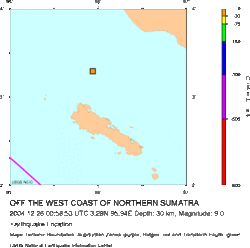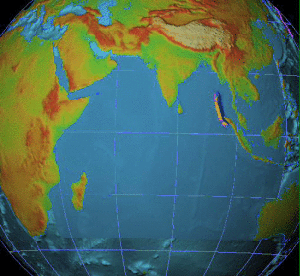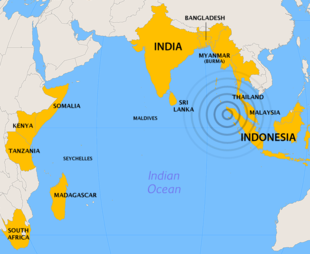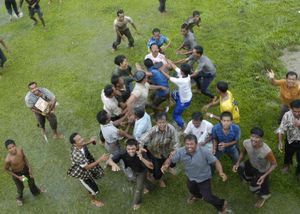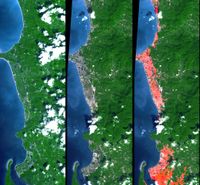2004 Indian Ocean earthquake
2007 Schools Wikipedia Selection. Related subjects: Geology and geophysics
The 2004 Indian Ocean earthquake, known by the scientific community as the Sumatra-Andaman earthquake, was an undersea earthquake that occurred at 00:58:53 UTC (07:58:53 local time) December 26, 2004 with an epicentre off the west coast of Sumatra, Indonesia. The earthquake triggered a series of devastating tsunamis that spread throughout the Indian Ocean, killing large numbers of people and inundating coastal communities across South and Southeast Asia, including parts of Indonesia, Sri Lanka, India, and Thailand. Although initial estimates have put the worldwide death toll at over 275,000 with thousands of others missing, recent analysis compiled lists a total of 229,866 persons lost, including 186,983 dead and 42,883 missing. The figure excludes 400 to 600 people who are believed to have perished in Myanmar which is more than that government's official figure of only 61 dead. The catastrophe is one of the deadliest disasters in modern history. The disaster is known in Asia and in the international media as the Asian Tsunami, and also called the Boxing Day Tsunami in Australia, Canada, New Zealand, and the United Kingdom as it took place on Boxing Day. Coincidentally, the tsunami occurred exactly one year after the 2003 earthquake that devastated the southern Iranian city of Bam.
The magnitude of the earthquake was originally recorded as 9.0 on the Richter scale, but has been upgraded to between 9.1 and 9.3. At this magnitude, it is the second largest earthquake ever recorded on a seismograph. This earthquake was also reported to be the longest duration of faulting ever observed, lasting between 500 and 600 seconds, and it was large enough that it caused the entire planet to vibrate at least half an inch, or over a centimetre. It also triggered earthquakes in other locations as far away as Alaska.
The earthquake originated in the Indian Ocean just north of Simeulue island, off the western coast of northern Sumatra. The resulting tsunami devastated the shores of Indonesia, Sri Lanka, India, Thailand and other countries with waves up to 30 m (100 ft). It caused serious damage and deaths as far as the east coast of Africa, with the furthest recorded death due to the tsunami occurring at Rooi Els in South Africa, 8,000 km (5,000 mi) away from the epicentre. In total, eight people in South Africa died due to abnormally high sea levels and waves.
The plight of the many affected people and countries prompted a widespread humanitarian response. In all, the worldwide community donated more than US$7 billion in humanitarian aid to those affected by the earthquake.
Earthquake characteristics
The earthquake was initially reported as moment magnitude, Mw 9.0. (Notice that this is not the so-called Richter scale or local magnitude scale, ML, which is known to saturate at higher magnitudes.) In February 2005 some scientists revised the estimate of the magnitude to 9.3. Although the Pacific Tsunami Warning Centre has accepted these new numbers, the United States Geological Survey has so far not changed its estimate of 9.1. The most recent studies in 2006 have obtained a magnitude of Mw 9.1 to 9.3. Dr. Hiroo Kanamori of the California Institute of Technology believes that Mw = 9.2 is a good representative value for the size of this great earthquake. Reference: EERI Publication 2006-06, page 14 [www.eeri.org]
The hypocentre of the main earthquake was at 3.316°N, 95.854°E (), approximately 160 km (100 mi) west of Sumatra, at a depth of 30 km (19 mi) below mean sea level (initially reported as 10 km). The earthquake itself (apart from the tsunami) was felt as far away as Bangladesh, India, Malaysia, Myanmar, Thailand, Singapore and the Maldives.
Indonesia lies between the Pacific Ring of Fire along the north-eastern islands adjacent to and including New Guinea and the Alpide belt along the south and west from Sumatra, Java, Bali, Flores, and Timor. The December 2004 earthquake actually occurred within the Alpide belt.
Since 1900 the only earthquakes recorded with a greater magnitude were the 1960 Great Chilean Earthquake (magnitude 9.5) and the 1964 Good Friday Earthquake in Prince William Sound (9.2). The only other recorded earthquake of magnitude 9.0 or greater was off Kamchatka, Russia, on November 4, 1952 (magnitude 9.0). Each of these megathrust earthquakes also spawned tsunamis in the Pacific Ocean, but the death toll from these was significantly lower. The worst of these caused only a few thousand deaths, primarily because of the lower population density along the coasts near affected areas and the much greater distances to more populated coasts.
Other very large megathrust earthquakes occurred in 1868 (Peru, Nazca Plate and South American Plate); 1827 (Colombia, Nazca Plate and South American Plate); 1812 (Venezuela, Caribbean Plate and South American Plate) and 1700 ( Cascadia Earthquake, western U.S. and Canada, Juan de Fuca Plate and North American Plate). These are all believed to have been of greater than magnitude 9, but no accurate measurements were available at the time.
Tectonic plates
The earthquake was unusually large in geographical extent. An estimated 1,200 km (750 mi) of faultline slipped about 15 m (50 ft) along the subduction zone where the India Plate dives under the Burma Plate. The slip did not happen instantaneously but took place in two phases over a period of several minutes. Seismographic and acoustic data indicate that the first phase involved the formation of a rupture about 400 km (250 mi) long and 100 km (60 mi) wide, located 30 km (19 mi) beneath the sea bed—the longest rupture ever known to have been caused by an earthquake. The rupture proceeded at a speed of about 2.8 km/s (1.7 mi/s) or 10,000 km/h (6,300 mph), beginning off the coast of Aceh and proceeding north-westerly over a period of about 100 seconds. A pause of about another 100 seconds took place before the rupture continued northwards towards the Andaman and Nicobar Islands. However, the northern rupture occurred more slowly than in the south, at about 2.1 km/s (1.3 mi/s) or 7,600 km/h (4,700 mph), continuing north for another five minutes to a plate boundary where the fault changes from subduction to strike-slip (the two plates push past one another in opposite directions). This reduced the speed of the water displacement and so reducing the size of the tsunami that hit the northern part of the Indian Ocean.
The India Plate is part of the great Indo-Australian Plate, which underlies the Indian Ocean and Bay of Bengal, and is drifting north-east at an average of 6 cm/year (2 inches per year). The India Plate meets the Burma Plate (which is considered a portion of the great Eurasian Plate) at the Sunda Trench. At this point the India Plate subducts beneath the Burma Plate, which carries the Nicobar Islands, the Andaman Islands and northern Sumatra. The India Plate slips deeper and deeper beneath the Burma Plate until the increasing temperature and pressure drive volatiles out of the subducting plate. These volatiles rise into the crust above and trigger melt which exits the earth's crust through volcanoes in the form of a volcanic arc. The volcanic activity that results as the Indo-Australian plate subducts the Eurasian plate has created the Sunda Arc.
As well as the sideways movement between the plates, the sea bed is estimated to have risen by several metres, displacing an estimated 30 km³ (7 cu mi) of water and triggering devastating tsunami waves. The waves did not originate from a point source, as mistakenly depicted in some illustrations of their spread, but radiated outwards along the entire 1,200 km (750 mi) length of the rupture (acting as a line source). This greatly increased the geographical area over which the waves were observed, reaching as far as Mexico, Chile and the Arctic. The raising of the sea bed significantly reduced the capacity of the Indian Ocean, producing a permanent rise in the global sea level by an estimated 0.1 mm.
Aftershocks and other earthquakes
Numerous aftershocks were reported off the Andaman Islands, the Nicobar Islands and the region of the original epicentre in the hours and days that followed. The largest aftershock of magnitude 8.7 was located off the Sumatran island of Nias. A debate arose among seismologists over whether the 2005 Sumatra earthquake should be considered an aftershock of the December 2004 event or a "triggered earthquake" (an earthquake brought about by a previous earthquake), as it was larger than typical aftershocks but on the same fault. Other aftershocks of up to magnitude 6.6 continued to shake the region daily for up to three or four months. As well as continuing aftershocks, the energy released by the original earthquake continued to make its presence felt well after the event. A week after the earthquake, its reverberations could still be measured, providing valuable scientific data about the Earth's interior.
The 2004 Indian Ocean earthquake came just three days after a magnitude 8.1 earthquake in an uninhabited region west of New Zealand's sub-Antarctic Auckland Islands, and north of Australia's Macquarie Island. This is unusual, since earthquakes of magnitude 8 or more occur only about once per year on average. Some seismologists have speculated about a connection between these two earthquakes, saying that the former one might have been a catalyst to the Indian Ocean earthquake, as the two earthquakes happened on opposite sides of the Indo-Australian Plate. However, the U.S. Geological Survey sees no evidence of a causal relationship in this incident. Coincidentally, the earthquake struck almost exactly one year (to the hour) after a 6.6 magnitude earthquake killed an estimated 30,000 people in the city of Bam in Iran on December 26, 2003.
An earthquake of magnitude 8.7 was reported shortly at 16:09:37 UTC (23:09:37 local time) on March 28, 2005, approximately at the same location (see 2005 Sumatran earthquake). It was likely a very large aftershock of the original earthquake. This earthquake had strong aftershocks of its own, including magnitude 6.0 and 6.1 earthquakes. At 8.7 it ranks as the 7th largest earthquake since 1900. A 6.7 magnitude earthquake struck on April 10, 2005, at 10:29 UTC (17:29 local time) about 120 km (75 mi) south-west of the city of Padang.
Some scientists confirm that the December earthquake had activated Leuser Mountain, a volcano in Aceh province along the same range of peaks as Mount Talang, while the 2005 Sumatran earthquake had sparked activity in Lake Toba, an ancient crater in Sumatra. Geologists say that the eruption of Mount Talang in April 2005 is connected to the December earthquake.
Power of the earthquake
The total energy released by the 2004 Indian Ocean earthquake has been estimated as 3.35 exajoules (3.35×1018 joules). This is equivalent to over 930 terawatt hours, 0.8 gigatons of TNT, or about as much energy as is used in the United States in 11 days. However, the most reliable seismic energy release estimate, as of September 30, 2005, is 1.1×1018 joules. This corresponds to about 0.25 gigatons of TNT. The earthquake is estimated to have resulted in an oscillation of the Earth's surface of about 20–30 cm (8–12 in), equivalent to the effect of the tidal forces caused by the Sun and Moon. The shock waves of the earthquake were felt across the planet; as far away as the U.S. state of Oklahoma, where vertical movements of 3 mm (0.12 in) were recorded. The entire Earth's surface is estimated to have moved vertically by up to 1 cm.
The shift of mass and the massive release of energy very slightly altered the Earth's rotation. The exact amount is yet undetermined, but theoretical models suggest the earthquake shortened the length of a day by 2.68 microseconds (2.68 µs, or about one billionth of the length of a day), due to a decrease in the oblateness of the Earth. It also caused the Earth to minutely "wobble" on its axis by up to 2.5 cm (1 in) in the direction of 145° east longitude, or perhaps by up to 5 or 6 cm (2.0 to 2.4 in). However, because of tidal effects of the Moon, the length of a day increases at an average of 15 µs per year, so any rotational change due to the earthquake will be lost quickly. Similarly, the natural Chandler wobble of the Earth can be up to 15 m (50 ft).
More spectacularly, there was 10 m (33 ft) movement laterally and 4–5 m (13–16 ft) vertically along the fault line. Early speculation was that some of the smaller islands south-west of Sumatra, which is on the Burma Plate (the southern regions are on the Sunda Plate), may have moved south-west by up to 20 m (66 ft), and some early estimates said up to 36 m (118 ft). However, more accurate data released, more than a month following the earthquake, present a more manageable figure of 20 cm (7.9 in). Since movement was vertical as well as lateral, some coastal areas may have been moved to below sea level. The Andaman and Nicobar Islands appear to have shifted south-west by around 1.25 m (4.1 ft) and to have sunk by 1 m (3.28 ft).
In February 2005 the Royal Navy vessel HMS Scott surveyed the seabed around the earthquake zone, which varies in depth between 1,000 m and 5,000 m (3,300 ft and 16,500 ft) west of Sumatra. The survey, conducted using a high-resolution, multi-beam sonar system, revealed that the earthquake had made a huge impact on the topography of the seabed. Previous activity on the fault over geological periods of time had created large thrust ridges, about 1,500 m high, which collapsed in places during the earthquake to produce large landslides several kilometres across. One landslide consisted of a single block of material some 100 m high and 2 km long (300 ft by 1.25 mi). The force of the displaced water was such that individual blocks of rock, massing millions of tons apiece, were dragged as much as 10 km (7 mi) across the seabed. An oceanic trench several kilometres wide was exposed in the earthquake zone.
By a beneficial and remarkable coincidence, the TOPEX/Poseidon and Jason 1 satellites happened to pass over the tsunami as it was crossing the ocean. These satellites carry radars that measure precisely the height of the water surface; anomalies of the order of 50 cm (20 in) were measured. Measurements from these satellites may prove invaluable for the understanding of the earthquake and tsunami. Unlike data from tide gauges installed on shores, measurements obtained in the middle of the ocean can be used for computing the parameters of the source earthquake without having to compensate for complex effects close to the coast. Inversion of this height data may help adjust the parameters for the source earthquake.
Tsunami characteristics
The sudden vertical rise of the seabed by several metres during the earthquake displaced massive volumes of water, resulting in a tsunami that struck the coasts of the Indian Ocean. A tsunami which causes damage far away from its source is sometimes called a "teletsunami", and is much more likely to be produced by vertical motion of the seabed than by horizontal motion.
The tsunami, like all others, behaved very differently in deep water than in shallow water. In deep ocean water, tsunami waves form only a small hump, barely noticeable and harmless, which generally travels at a very high speed of 500 to 1,000 km/h (310 to 620 mph); in shallow water near coastlines, a tsunami slows down to only tens of kilometres an hour but in doing so forms large destructive waves. Scientists investigating the damage in Aceh found evidence that the wave reached a height of 24 m (80 ft) when coming ashore along large stretches of the coastline, rising to 30 m (100 ft) in some areas when travelling inland.
Radar satellites recorded the heights of tsunami waves in deep water: at two hours after the earthquake, the maximum height was 60 cm (2 ft). These are the first such observations ever made. However, these observations could not have been used to provide a warning, because the satellites were not intended for that purpose and the data took hours to analyse.
According to Tad Murty, vice-president of the Tsunami Society, the total energy of the tsunami waves was equivalent to about five megatons of TNT (20 petajoules). This is more than twice the total explosive energy used during all of World War II (including the two atomic bombs), but still a couple of orders of magnitude less than the energy released in the earthquake itself. In many places the waves reached as far as 2 km (1.24 mi) inland.
Because the 1,200 km (745.6 mi) of faultline affected by the earthquake was in a nearly north-south orientation, the greatest strength of the tsunami waves was in an east-west direction. Bangladesh, which lies at the northern end of the Bay of Bengal, had very few casualties despite being a low-lying country relatively near the epicentre. It also benefited from the fact that the earthquake proceeded more slowly in the northern rupture zone, greatly reducing the energy of the water displacements in that region.
Coasts that have a landmass between them and the tsunami's location of origin are usually safe; however, tsunami waves can sometimes diffract around such landmasses. Thus, the Indian state of Kerala was hit by the tsunami despite being on the western coast of India, and the western coast of Sri Lanka also suffered substantial impacts. Also distance alone is no guarantee of safety; Somalia was hit harder than Bangladesh despite being much farther away.
Because of the distances involved, the tsunami took anywhere from fifteen minutes to seven hours (for Somalia) to reach the various coastlines. The northern regions of the Indonesian island of Sumatra were hit very quickly, while Sri Lanka and the east coast of India were hit roughly 90 minutes to two hours later. Thailand was also struck about two hours later despite being closer to the epicentre, because the tsunami travelled more slowly in the shallow Andaman Sea off its western coast.
The tsunami was noticed as far as Struisbaai in South Africa, some 8,500 km (5,300 mi) away, where a 1.5 m (5 ft) high tide surged on shore about 16 hours after the earthquake. It took a relatively long time to reach this spot at the southernmost point of Africa, probably because of the broad continental shelf off South Africa and because the tsunami would have followed the South African coast from east to west. The tsunami also reached Antarctica, where tidal gauges at Japan's Syowa Base recorded oscillations of up to a meter, with disturbances lasting a couple of days.
Some of the tsunami's energy escaped into the Pacific Ocean, where it produced small but measurable tsunamis along the western coasts of North and South America, typically around 20 to 40 cm (7.9 to 15.7 in). At Manzanillo, Mexico, a 2.6 m (8.5 ft) crest-to-trough tsunami was measured. This puzzled many scientists, as the tsunamis measured in some parts of South America were larger than those measured in some parts of the Indian Ocean. It has been theorised that the tsunamis were focused and directed at long ranges by the mid-ocean ridges which run along the margins of the continental plates.
Signs and warnings
Despite a lag of up to several hours between the earthquake and the impact of the tsunami, nearly all of the victims were taken completely by surprise. There were no tsunami warning systems in the Indian Ocean to detect tsunamis or to warn the general populace living around the ocean. Tsunami detection is not easy because while a tsunami is in deep water it has little height and a network of sensors is needed to detect it. Setting up the communications infrastructure to issue timely warnings is an even bigger problem, particularly in a relatively poor part of the world.
Tsunamis are much more frequent in the Pacific Ocean because of earthquakes in the "Ring of Fire", and an effective tsunami warning system has long been in place there. Although the extreme western edge of the Ring of Fire extends into the Indian Ocean (the point where this earthquake struck), no warning system exists in that ocean. Tsunamis there are relatively rare despite earthquakes being relatively frequent in Indonesia. The last major tsunami was caused by the Krakatoa eruption of 1883. It should be noted that not every earthquake produces large tsunamis; on March 28, 2005, a magnitude 8.7 earthquake hit roughly the same area of the Indian Ocean but did not result in a major tsunami.
In the aftermath of the disaster, there is now an awareness of the need for a tsunami warning system for the Indian Ocean. The United Nations started working on an Indian Ocean Tsunami Warning System and by 2005 had the initial steps in place. Some have even proposed creating a unified global tsunami warning system, to include the Atlantic Ocean and Caribbean.
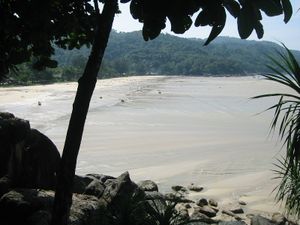
The first warning sign of a possible tsunami is the earthquake itself. However, tsunamis can strike thousands of miles away where the earthquake is only felt weakly or not at all. Also, in the minutes preceding a tsunami strike, the sea often recedes temporarily from the coast. People in Pacific regions are more familiar with tsunamis and often recognise this phenomenon as a sign to head for higher ground. However, around the Indian Ocean, this rare sight reportedly induced people, especially children, to visit the coast to investigate and collect stranded fish on as much as 2.5 km (1.6 mi) of exposed beach, with fatal results.
One of the few coastal areas to evacuate ahead of the tsunami was on the Indonesian island of Simeulue, very close to the epicentre. Island folklore recounted an earthquake and tsunami in 1907, and the islanders fled to inland hills after the initial shaking yet before the tsunami struck. On Maikhao beach in northern Phuket, Thailand, a 10-year-old British girl named Tilly Smith had studied tsunamis in geography class at school and recognised the warning signs of the receding ocean and frothing bubbles. She and her parents warned others on the beach, which was evacuated safely. John Chroston, a biology teacher from Scotland, also recognised the signs at Kamala Bay north of Phuket, taking a busload of vacationers and locals to safety on higher ground.
Retreat and rise cycle
The tsunami was a succession of several waves, occurring in retreat and rise cycles with a period of over 30 minutes between each peak. The third wave was the most powerful and reached highest, occurring about an hour and a half after the first wave. Smaller tsunamis continued to occur for the rest of the day.
|
Second tsunami wave starting to retreat, Kata Noi Beach, Thailand, 10:17 a.m. |
Damage and casualties
The U.S. Geological Survey initially recorded the toll as 283,100 killed, 14,100 missing, and 1,126,900 people displaced. Early news reports after the earthquake spoke of a toll in the hundreds, but the numbers rose steadily over the following week. However, more recent figures indicate that the actual casualties were 186,983 dead and 42,883 missing, for a total of 229,866, as more and more displaced survivors have been found and name duplications eliminated from the lists of victims. Measured in lives lost, this is one of the ten worst earthquakes in recorded history, as well as the single worst tsunami in history.
Relief agencies report that one-third of the dead appear to be children. This is a result of the high proportion of children in the populations of many of the affected regions and because children were the least able to resist being overcome by the surging waters. Oxfam went on to report that as many as four times more women than men were killed in some regions because they were waiting on the beach for the fishermen to return and looking after their children in the houses.
In addition to the large number of local residents, up to 9,000 foreign tourists (mostly Europeans) enjoying the peak holiday travel season were among the dead or missing, especially people from the Nordic countries. The European nation hardest hit may have been Sweden, whose death toll was 428 dead, with 116 missing.
States of emergency were declared in Sri Lanka, Indonesia, and the Maldives. The United Nations has declared that the current relief operation will be the costliest ever. UN Secretary-General Kofi Annan has stated that reconstruction would probably take between five and ten years. Governments and non-governmental organisations fear the final death toll may double as a result of diseases, prompting a massive humanitarian response.
For purposes of establishing timelines of local events, the time zones of affected areas are: UTC+3: (Kenya, Madagascar, Somalia, Tanzania); UTC+4: (Mauritius, Réunion, Seychelles); UTC+5: (Maldives); UTC+5:30: (India); UTC+6: (Bangladesh, Sri Lanka); UTC+6:30: (Cocos Islands, Myanmar); UTC+7: (Indonesia (western), Thailand); UTC+8: (Malaysia, Singapore). Since the earthquake occurred at 00:58:53 UTC, add the above offsets to find the local time of the earthquake.
| Country where deaths occurred |
Deaths | Injured | Missing | Displaced | |
|---|---|---|---|---|---|
| Confirmed | Estimated1 | ||||
| Indonesia | 130,736 | 167,736 | — | 37,063 | 500,000+ |
| Sri Lanka2 | 35,322 | 35,322 | 21,411 | 516,150 | |
| India | 12,405 | 18,045 | — | 5,640 | 647,599 |
| Thailand | 5,3953 | 8,212 | 8,457 | 2,817 | 7,000 |
| Somalia | 78 | 289 | — | — | 5,000 |
| Myanmar (Burma) | 61 | 400-600 | 45 | 200 | 3,200 |
| Maldives | 82 | 108 | — | 26 | 15,000+ |
| Malaysia | 68– 69 | 75 | 299 | 6 | — |
| Tanzania | 10 | 13 | — | — | — |
| Seychelles | 3 | 3 | 57 | — | 200 |
| Bangladesh | 2 | 2 | — | — | — |
| South Africa | 24 | 2 | — | — | — |
| Yemen | 2 | 2 | — | — | — |
| Kenya | 1 | 1 | 2 | — | — |
| Madagascar | — | — | — | — | 1,000+ |
| Total | ~184,168 | ~230,210 | ~125,000 | ~45,752 | ~1.69 million |
Note: All figures are approximate and subject to change. The first column links to more details on specific countries.
1 Includes those reported under 'Confirmed'. If no separate estimates are available, the number in this column is the same as reported under 'Confirmed'.
2 Does not include approximately 19,000 missing people initially declared by Tamil Tiger authorities from regions under their control .
3 Data includes at least 2,464 foreigners.
4 Does not include South African citizens who died outside of South Africa (eg, tourists in Thailand). For more information on those deaths, see this
Countries affected
The earthquake and resulting tsunami affected many countries in Southeast Asia and beyond, including Indonesia, Sri Lanka, India, Thailand, the Maldives, Somalia, Myanmar, Malaysia, Seychelles and others. Many other countries, especially Australia and those in Europe, had large numbers of citizens traveling in the region on holiday. Countries like Sweden and Germany lost over 500 citizens in the disaster.
Casualties in historical context
This earthquake was the fourth most powerful earthquake recorded since 1900, and the confirmed death toll is just under 200,000 due to the ensuing tsunami. The deadliest earthquakes since 1900 were the Tangshan, China earthquake of 1976, in which at least 255,000 were killed; the earthquake of 1927 in Xining, Qinghai, China (200,000); the Great Kanto earthquake which struck Tokyo in 1923 (143,000); and the Gansu, China, earthquake of 1920 (200,000). The deadliest known earthquake in history occurred in 1556 in Shaanxi, China, with an estimated death toll of 830,000, though figures from this time period may not be reliable.
| Deadliest earthquakes | ||||
|---|---|---|---|---|
| Rank | Earthquake | Country | Year | Fatalities |
| 1 | "Shaanxi" | China | 1556 | 830,000 |
| 2 | "Indian Ocean" | nr. Indonesia | 2004 | 283,100 |
| 3 | "Tangshan" | China | 1976 | 242,000 |
| 4 | "Aleppo" | Syria | 1138 | 230,000 |
| 5 | "Gansu" | China | 1920 | c. 200,000 |
|
|
||||
The 2004 tsunami is the deadliest in recorded history. Prior to 2004, the deadliest recorded tsunami in the Pacific Ocean was in 1782, when 40,000 people were killed by a tsunami in the South China Sea. The tsunami created by the 1883 eruption of Krakatoa is thought to have resulted in 36,000 deaths. The most deadly tsunami between 1900 and 2004 occurred in 1908 in Messina, Italy, on the Mediterranean Sea, where the earthquake and tsunami killed 70,000. The most deadly tsunami in the Atlantic Ocean resulted from the 1755 Lisbon earthquake, which, combined with the toll from the actual earthquake and resulting fires, killed over 100,000.
The 2004 earthquake and tsunami seem to be the deadliest natural disaster since either the 1976 Tangshan earthquake or the 1970 Bhola cyclone, or could conceivably exceed both of these. Because of uncertainty over death tolls, it might never be known for sure which of these natural disasters was the deadliest.
Human component in magnitude of damage
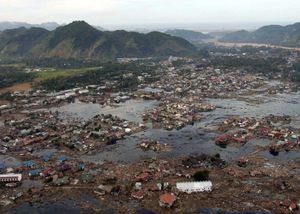
The human destruction of coral reefs played a significant role in the destruction caused by the tsunami. Many countries across Asia, including Indonesia, Sri Lanka and Bangladesh, have put forth efforts to destroy the coral surrounding their beaches, and instead make way for shrimp farms and other economic choices. On the Surin Island chain of Thailand's coast, many people were saved as the tsunami rushed against the coral reefs protecting the islands. However, there were many fewer people on these islands, which helps explain the lower death toll. Many reefs areas around the Indian Ocean have been exploded with dynamite because they are considered impediments to shipping, an important part of the South Asian economy. Similarly, the removal of coastal mangrove trees is believed to have intensified the effect of the tsunami in some locations. These trees, which lined the coast but were removed to make way for coastal residences, might have blocked the force of the tsunami. Another factor is the removal of coastal sand dunes.
Humanitarian, economic and environmental impact
A great deal of humanitarian aid was needed because of widespread damage of the infrastructure, shortages of food and water, and economic damage. Epidemics were of special concern due to the high population density and tropical climate of the affected areas. The main concern of humanitarian and government agencies was to provide sanitation facilities and fresh drinking water to contain the spread of diseases such as cholera, diphtheria, dysentery, typhoid and hepatitis A and B.
There was also a great concern that the death toll could rise further as diseases and hunger spread. However, because of the initial quick response, this was minimised.
In the days after the event, significant effort was spent in burying bodies hurriedly for fear of disease. However, the public health risks may have been exaggerated, and therefore this may not have been the best way to allocate resources. The World Food Programme provided food aid to more than 1.3 million people affected by the tsunami.
Nations all over the world provided over US$7 billion in aid for damaged regions, with the governments of Australia pledging US$819.9 million (including a US$760.6-million aid package for Indonesia), Germany offering US$660 million, Japan offering US$500 million, Canada offering US$343 million, Norway and The Netherlands offering both US$183 million, the United States offering US$35 million initially (increased to US$350 million), and the World Bank offering US$250 million. According to USAID, the US has pledged additional funds in long-term U.S. support to help the tsunami victims rebuild their lives. On February 9, 2005, President Bush asked Congress to increase the U.S. commitment to a total of $950 million. Officials estimated that billions of dollars would be needed. Bush also asked his father, former President George H. W. Bush, and former President Bill Clinton to lead a U.S. effort to provide private aid to the tsunami victims.
In mid-March the Asian Development Bank reported that over US$4 billion in aid promised by governments was behind schedule. Sri Lanka reported that it had received no foreign government aid, while foreign individuals had been generous. Lots of charities were given considerable donations from the public. For example, in the UK the public donated roughly £330,000,000 sterling (nearly US$600,000,000). This considerably outweighed the donation by the government and came to about £5.50 (US$10) donated by each and every citizen.
In August 2006, fifteen local aid staff working on post-tsunami rebuilding have been found executed in northeast Sri Lanka after heavy fighting, the main umbrella body for aid agencies in the country said. There had been reports and rumors that the local aid workers had been killed.
Economic impact
The impact on coastal fishing communities and fisherfolk, some of the poorest people in the region, has been devastating with high losses of income earners as well as boats and fishing gear. In Sri Lanka artisanal fishery, where the use of fish baskets, fishing traps, and spears are commonly used, is an important source of fish for local markets; industrial fishery is the major economic activity, providing direct employment to about 250,000 people. In recent years the fishery industry has emerged as a dynamic export-oriented sector, generating substantial foreign exchange earnings. Preliminary estimates indicate that 66% of the fishing fleet and industrial infrastructure in coastal regions have been destroyed by the wave surges, which will have adverse economic effects both at local and national levels.
But some economists believe that damage to the affected national economies will be minor because losses in the tourism and fishing industries are a relatively small percentage of the GDP. However, others caution that damage to infrastructure is an overriding factor. In some areas drinking water supplies and farm fields may have been contaminated for years by salt water from the ocean.
Both the earthquake and the tsunami may have affected shipping in the Malacca Straits by changing the depth of the seabed and by disturbing navigational buoys and old shipwrecks. Compiling new navigational charts may take months or years.
Countries in the region appealed to tourists to return, pointing out that most tourist infrastructure is undamaged. However, tourists were reluctant to do so for psychological reasons. Even resorts on the Pacific coast of Thailand, which were completely untouched, were hit by cancellations. One year after the tsunami hit, tourism is beginning to climb again, with a full recovery expected sometime in 2006.
Environmental impact
Beyond the heavy toll on human lives, the Indian Ocean earthquake has caused an enormous environmental impact that will affect the region for many years to come. It has been reported that severe damage has been inflicted on ecosystems such as mangroves, coral reefs, forests, coastal wetlands, vegetation, sand dunes and rock formations, animal and plant biodiversity and groundwater. In addition, the spread of solid and liquid waste and industrial chemicals, water pollution and the destruction of sewage collectors and treatment plants threaten the environment even further, in untold ways. The environmental impact will take a long time and significant resources to assess.
According to specialists, the main effect is being caused by poisoning of the freshwater supplies and the soil by saltwater infiltration and deposit of a salt layer over arable land. It has been reported that in the Maldives, 16 to 17 coral reef atolls that were overcome by sea waves are totally without fresh water and could be rendered uninhabitable for decades. Uncountable wells that served communities were invaded by sea, sand and earth; and aquifers were invaded through porous rock. Salted-over soil becomes sterile, and it is difficult and costly to restore for agriculture. It also causes the death of plants and important soil micro-organisms. Thousands of rice, mango and banana plantations in Sri Lanka were destroyed almost entirely and will take years to recover. The United Nations Environment Programme (UNEP) is working with governments of the region in order to determine the severity of the ecological impact and how to address it. UNEP has decided to earmark a US$1,000,000 emergency fund and to establish a Task Force to respond to requests for technical assistance from countries affected by the tsunami. In response to a request from the Maldivian Government, the Australian Government sent ecological experts to help restore marine environments and coral reefs—the lifeblood of Maldivian tourism. Much of the ecological expertise has been rendered from work with the Great Barrier Reef, in Australia's north-eastern waters.
Other effects

Many health professionals and aid workers have reported widespread psychological trauma associated with the tsunami. Traditional beliefs in many of the affected regions state that a relative of the family must bury the body of the dead. Some psychologists interpret this as evidence of psychological trauma.
The hardest hit area, Aceh, is considered to be a religiously conservative Islamic society and has had no tourism nor any Western presence in recent years due to armed conflict between the Indonesian military and Acehnese separatists. Some believe that the tsunami was punishment for lay Muslims shirking their daily prayers and/or following a materialistic lifestyle. Others have said that Allah was angry that there were Muslims killing other Muslims in an ongoing conflict. In what may be the most significant positive result of the tsunami, the widespread devastation led the main rebel group GAM to declare a cease-fire on December 28, 2004, followed by the Indonesian government, and the two groups resumed long-stalled peace talks, which resulted in a peace agreement signed August 15, 2005. The agreement explicitly cites the tsunami as a justification.
The extensive international media coverage of the tsunami, and the role of mass media and journalists in reconstruction, were discussed by editors of newspapers and broadcast media in tsunami-affected areas, in special video-conferences set up by the Asia Pacific Journalism Centre.
In another positive note of the tsunami, the water washed away centuries of sand from some of the ruins of a 1,200-year-old lost city at Mahabalipuram on the south coast of India. The site, containing such notable structures as a half-buried granite lion near a 7th-century Mahablipuram temple and a relic depicting an elephant, is part of what archaeologists believe to be an ancient port city that was swallowed by the sea hundreds of years ago.

